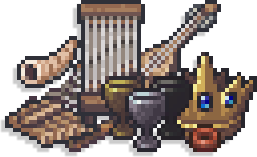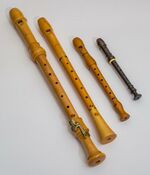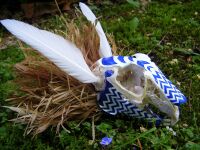- v50 information can now be added to pages in the main namespace. v0.47 information can still be found in the DF2014 namespace. See here for more details on the new versioning policy.
- Use this page to report any issues related to the migration.
Difference between revisions of "Finished goods"
(Nintendo Game cube reference) |
CobaltNinja (talk | contribs) m (→Materials: Changed grammar.) |
||
| Line 106: | Line 106: | ||
The existence of toy boats indicate that the dwarf civilization does have the concept of using specialized vehicles to travel on water. However, due to the nature of [[Physics |Urist's principle]], there is some difficulty in scaling them up to a usable level. | The existence of toy boats indicate that the dwarf civilization does have the concept of using specialized vehicles to travel on water. However, due to the nature of [[Physics |Urist's principle]], there is some difficulty in scaling them up to a usable level. | ||
| − | Some dwarven children insist | + | Some dwarven children insist on calling puzzleboxes "game cubes". Scholars have yet to determine why. |
{{Category|Items}} | {{Category|Items}} | ||
{{Industry}} | {{Industry}} | ||
[[ru:Finished goods]] | [[ru:Finished goods]] | ||
Revision as of 16:26, 30 October 2023
v52.04 · v0.47.05 This article is about the current version of DF.Note that some content may still need to be updated. |
Finished goods are items that go to a finished goods stockpile when made. Many of these items are frequently referred to as trade goods as they are lightweight and suitably valuable for trading. They include crafts, goblets, instruments, toys and totems, some of which have several subtypes.
Finished good types with several subtypes may have generic workshop orders to produce random subtype items, e.g. "Make crafts". Additionally, some specific subtypes of goods can be ordered directly at an appropriate workshop or through the manager. If you have a mandate to make rings, you can order rings directly, instead of waiting for a generic "crafts" job to produce rings; others, like puzzleboxes, though, can only be produced by generic jobs ("toys").
Some types of trade goods (crafts and goblets) can be produced in multiples. It is possible to get up to three crafts from a single resource. Skill does not affect the chance to produce multiples.
Types of trade goods
Clothing
All clothing is stored in finished goods piles. Dwarves will replace their worn-out clothing automatically. Clothes can also be exported, but they are not especially valuable, unless they're made of exotic materials, like giant cave spider silk.
Crafts
Crafts include figurines, rings, earrings, amulets, bracelets, crowns, and scepters. Some subtypes of crafts can reference historical figures and events (figurines, for example); this does not have any meaningful effect on the value of the craft.
One generic order to "make crafts" consumes one resource and produces one to three items, two on average. All subtypes, if they can be produced from the chosen material, have an identical chance to be produced. Some crafts, such as bracelets, can be worn by dwarves like clothing.
Gem and glass crafts cannot be made directly. They may only be produced randomly by gem cutting jobs.
Flasks
Metal flasks are made at a metalsmith's forge. Leather flasks are called waterskins, and are made in a leather works. Glass flasks are called vials, and are made in a glass furnace. Flasks will be used by soldiers and hunters, allowing them to transport water or booze for drinking.
Goblets
¶ Goblets have no subtypes, but have different names depending on the material from which they are made: metal and glass goblets are simply goblets, stone goblets are called mugs, and wooden goblets are called cups.
Goblets are always produced at a 3:1 ratio. Metal goblets are made at a metalsmith's forge. Glass goblets are made at a glass furnace. Rock mugs and wooden cups are made at a craftsdwarf's workshop.
Goblets can be used by dwarves for drinking. If no goblets are available in a dining room stockpile or a coffer in a tavern, a thirsty dwarf can drink alcohol straight from the barrel, but this will result in an unhappy thought. If a dwarf is unable to use their arms, they will stall on picking up a goblet rather than drinking straight from the barrelBug:9440. Goblets can also be used to transport liquids in adventurer mode.
Instruments
¿ Instruments can be composed of one or more components made from specific materials. The presence of multiple high-value components can increase the trade value of an instrument far beyond any other finished good. Instruments can also be used by performers in taverns or temples.
Toys
æ Toys include mini-forges, toy hammers, toy axes, toy boats, and puzzleboxes. Dwarven children can play with toys.
Totems
ç Totems are made from skulls by a bone carver at a craftsdwarf's workshop.
Although totems have the same base value as all other crafts, totems made from the skulls of more valuable animals like unicorns will fetch a hefty price.
Large gems
♦ Large gems have no subtypes. Large gems can be ordered cut from every material except gems and glass (including beeswax and soap). For gem or glass large gems, a gem cutting job will occasionally produce a large gem. It can be assumed that this represents the rarity of large gem-quality rough gemstones, and the difficulty of creating thick evenly structured glass pieces. Large gems currently have no use beyond trade. The chance of gems being cut into large gems may have been disabled in early releases of the premium version of the game.
Materials
Most materials can be used to make trade goods - on occasion, a dwarf in a strange mood will make a trade good out of a material not normally suited for it (e. g., a bone toy).
| Material | Labor | Workshop | Crafts | Goblets | Toys | Large Gems | Instruments |
| Stone | Stonecrafting | Craftsdwarf's workshop | Y | Y | Y | Y | Y1 |
| Wood | Woodcrafting | Craftsdwarf's workshop | Y | Y | Y2 | Y | Y1 |
| Leather | Leatherworking | Craftsdwarf's workshop | Y4 | N | N | N | Y1 |
| Cloth3 | Clothesmaking | Craftsdwarf's workshop | Y4 | N | N | N | N |
| Bone5 | Bone carving | Craftsdwarf's workshop | Y | N | N | Y | Y1 |
| Shell | Bone carving | Craftsdwarf's workshop | Y | N | N | Y | Y1 |
| Horn | Bone carving | Craftsdwarf's workshop | Y | N | N | Y | Y1 |
| Ivory | Bone carving | Craftsdwarf's workshop | Y | N | N | Y | N |
| Pearl | Bone carving | Craftsdwarf's workshop | Y | N | N | Y | N |
| Ceramic | Pottery | Kiln or Magma kiln | Y | N | N | N | Y1 |
| Wax | Wax working | Craftsdwarf's workshop | Y | N | N | N | N |
| Metal | Metalcrafting | Metalsmith's forge or Magma forge | Y | Y | Y | Y | Y1 |
| Glass | Glassmaking | Glass furnace or Magma glass furnace | Y6 | Y | Y | Y6 | Y1 |
| Gems | Gem cutting | Jeweler's workshop | Y6 | N | N | Y6 | N |
1 Instruments and their components are procedurally generated items; the materials they can be made from depend on the particular world.
2 Wooden toys can only be made using the job manager, as the craftsdwarf's workshop interface does not permit selecting them. Bug:3119
3 Adamantine cloth cannot be used to make crafts. (Adamantine crafts can be created at a metalsmith's forge).
4 Amulets, earrings and bracelets are the only crafts that can be produced from leather, plant cloth, and silk cloth. All crafts can be produced from yarn cloth.
5 Skull totems, like bone crafts, are made by a bone carver at a craftsdwarf's workshop.
6 Prior to v50, crafts and large gems were produced randomly by cutting jobs at a jeweler's workshop, with the gem cutting labor. Raw glass possibly has a 33% chance to be cut into a large gem or a craft (with 11 crafts for every 16 large gems). Raw gems have a 5% chance to be cut into a large gem or a craft (with 1 craft for every 8 large gems).

|
This article or section has been rated D for Dwarf. It may include witty humour, not-so-witty humour, bad humour, in-jokes, pop culture references, and references to the Bay12 forums. Don't believe everything you read, and if you miss some of the references, don't worry. It was inevitable. |
The existence of toy boats indicate that the dwarf civilization does have the concept of using specialized vehicles to travel on water. However, due to the nature of Urist's principle, there is some difficulty in scaling them up to a usable level.
Some dwarven children insist on calling puzzleboxes "game cubes". Scholars have yet to determine why.
| Primary | |
|---|---|
| Secondary | |
| Tertiary | |
| Quaternary | |



